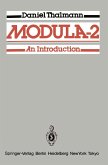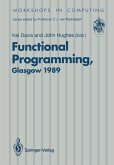Laszlo Böszörmenyi, Carsten WeichAn Introduction in Programming with Style
Programming in Modula-3 (eBook, PDF)
An Introduction in Programming with Style
Übersetzer: Bach, R.
40,95 €
40,95 €
inkl. MwSt.
Sofort per Download lieferbar

20 °P sammeln
40,95 €
Als Download kaufen

40,95 €
inkl. MwSt.
Sofort per Download lieferbar

20 °P sammeln
Jetzt verschenken
Alle Infos zum eBook verschenken
40,95 €
inkl. MwSt.
Sofort per Download lieferbar
Alle Infos zum eBook verschenken

20 °P sammeln
Laszlo Böszörmenyi, Carsten WeichAn Introduction in Programming with Style
Programming in Modula-3 (eBook, PDF)
An Introduction in Programming with Style
Übersetzer: Bach, R.
- Format: PDF
- Merkliste
- Auf die Merkliste
- Bewerten Bewerten
- Teilen
- Produkt teilen
- Produkterinnerung
- Produkterinnerung

Bitte loggen Sie sich zunächst in Ihr Kundenkonto ein oder registrieren Sie sich bei
bücher.de, um das eBook-Abo tolino select nutzen zu können.
Hier können Sie sich einloggen
Hier können Sie sich einloggen
Sie sind bereits eingeloggt. Klicken Sie auf 2. tolino select Abo, um fortzufahren.

Bitte loggen Sie sich zunächst in Ihr Kundenkonto ein oder registrieren Sie sich bei bücher.de, um das eBook-Abo tolino select nutzen zu können.
This introductory text shows how to write and understand programs in Modula-3. The reader is led step by step toward complex data structures and algorithms, as far as object-oriented and parallel programming.
- Geräte: PC
- ohne Kopierschutz
- eBook Hilfe
- Größe: 47.2MB
Andere Kunden interessierten sich auch für
![Modula-2 (eBook, PDF) Modula-2 (eBook, PDF)]() Daniel ThalmannModula-2 (eBook, PDF)72,95 €
Daniel ThalmannModula-2 (eBook, PDF)72,95 €![Functional Programming (eBook, PDF) Functional Programming (eBook, PDF)]() Functional Programming (eBook, PDF)40,95 €
Functional Programming (eBook, PDF)40,95 €![Specification and Transformation of Programs (eBook, PDF) Specification and Transformation of Programs (eBook, PDF)]() Helmut A. PartschSpecification and Transformation of Programs (eBook, PDF)40,95 €
Helmut A. PartschSpecification and Transformation of Programs (eBook, PDF)40,95 €![C Programming: The Essentials for Engineers and Scientists (eBook, PDF) C Programming: The Essentials for Engineers and Scientists (eBook, PDF)]() David R. BrooksC Programming: The Essentials for Engineers and Scientists (eBook, PDF)52,95 €
David R. BrooksC Programming: The Essentials for Engineers and Scientists (eBook, PDF)52,95 €![The Design of Well-Structured and Correct Programs (eBook, PDF) The Design of Well-Structured and Correct Programs (eBook, PDF)]() Suad AlagicThe Design of Well-Structured and Correct Programs (eBook, PDF)40,95 €
Suad AlagicThe Design of Well-Structured and Correct Programs (eBook, PDF)40,95 €![Prolog: The Standard (eBook, PDF) Prolog: The Standard (eBook, PDF)]() Pierre DeransartProlog: The Standard (eBook, PDF)80,95 €
Pierre DeransartProlog: The Standard (eBook, PDF)80,95 €![Variational Object-Oriented Programming Beyond Classes and Inheritance (eBook, PDF) Variational Object-Oriented Programming Beyond Classes and Inheritance (eBook, PDF)]() Mira MeziniVariational Object-Oriented Programming Beyond Classes and Inheritance (eBook, PDF)112,95 €
Mira MeziniVariational Object-Oriented Programming Beyond Classes and Inheritance (eBook, PDF)112,95 €-
-
-
This introductory text shows how to write and understand programs in Modula-3. The reader is led step by step toward complex data structures and algorithms, as far as object-oriented and parallel programming.
Dieser Download kann aus rechtlichen Gründen nur mit Rechnungsadresse in A, B, BG, CY, CZ, D, DK, EW, E, FIN, F, GR, HR, H, IRL, I, LT, L, LR, M, NL, PL, P, R, S, SLO, SK ausgeliefert werden.
Produktdetails
- Produktdetails
- Verlag: Springer Berlin Heidelberg
- Seitenzahl: 571
- Erscheinungstermin: 6. Dezember 2012
- Englisch
- ISBN-13: 9783642609404
- Artikelnr.: 53156308
- Verlag: Springer Berlin Heidelberg
- Seitenzahl: 571
- Erscheinungstermin: 6. Dezember 2012
- Englisch
- ISBN-13: 9783642609404
- Artikelnr.: 53156308
- Herstellerkennzeichnung Die Herstellerinformationen sind derzeit nicht verfügbar.
1 What is programming?.- 1.1 An informal introduction.- 1.2 The von Neumann Computer.- 1.3 Rigid thought structures.- 1.4 Programming in the small.- 1.5 Levels of programming.- 1.6 Programming and Computer science.- 2 Metalanguages.- 2.1 Definition of formal languages.- 2.2 Digits and numbers.- 2.3 Names.- 2.4 Arithmetic expressions.- 2.5 Extension for Modula-3 syntax.- 3 The structure of programs.- 3.1 Structuring.- 3.2 Language environment.- 3.3 The statics and dynamics of a program.- 3.4 Structure of Modula-3 programs.- 4 Predefined data types.- 4.1 Integers.- 4.2 Logical type.- 4.3 Characters.- 4.4 Texts.- 4.5 Floating-point numbers.- 5 Statements.- 5.1 The assignment.- 5.2 Structured Statements.- 5.3 Sequence.- 5.4 Branches.- 5.5 Loops.- 6 User-defined simple types.- 6.1 Enumeration.- 6.2 Subranges.- 7 Expressions and declarations.- 7.1 Expressions.- 7.2 Declarations.- 7.3 Equivalence of types.- 7.4 Subtypes.- 7.5 Assignment compatibility.- 7.6 Expression compatibility.- 8 Composite static types.- 8.1 Arrays.- 8.2 Records.- 8.3 Sets.- 8.4 Comparison of arrays, records and sets.- 8.5 Packed data types.- 9 Structuring algorithms.- 9.1 Block structure.- 9.2 Procedures and functions.- 9.3 Modes of parameter passing.- 9.4 Identifying the procedures.- 9.5 Name, type and default value of a parameter.- 9.6 Eval statement.- 9.7 Procedure types.- 10 Modules.- 10.1 Structure.- 10.2 Using modules.- 10.3 An example with graphic elements.- 10.4 Modularization.- 11 Dynamic data structures.- 11.1 Dynamism in static data structures.- 11.2 Dynamic data in Modula-3.- 11.3 Subtypes.- 11.4 Abstract and encapsulated data types.- 11.5 Dynamic structures.- 12 Recursion.- 12.1 Recursive algorithms.- 12.2 Recursive data structures.- 13 Objects.- 13.1 Object-oriented modeling.- 13.2 Object-oriented programming.- 13.3 Object types in Modula-3.- 13.4 Encapsulation of object types.- 14 Persistent data structures.- 14.1 Files.- 14.2 Files in Modula-3.- 14.3 Persistent variables.- 15 Exception handling.- 15.1 Exceptions in a program.- 15.2 Exception handling in Modula-3.- 15.3 Delaying exception handling.- 15.4 Strategies for exception handling.- 16 Parallel programming.- 16.1 Motivation for parallelism.- 16.2 Parallel programs.- 16.3 Threads in Modula-3.- 16.4 Shared variables.- 16.5 Message passing.- A small database.- B Language Definition.- C Library interfaces.- D Modula-3 language environments.
1 What is programming?.- 1.1 An informal introduction.- 1.2 The von Neumann Computer.- 1.3 Rigid thought structures.- 1.4 Programming in the small.- 1.5 Levels of programming.- 1.6 Programming and Computer science.- 2 Metalanguages.- 2.1 Definition of formal languages.- 2.2 Digits and numbers.- 2.3 Names.- 2.4 Arithmetic expressions.- 2.5 Extension for Modula-3 syntax.- 3 The structure of programs.- 3.1 Structuring.- 3.2 Language environment.- 3.3 The statics and dynamics of a program.- 3.4 Structure of Modula-3 programs.- 4 Predefined data types.- 4.1 Integers.- 4.2 Logical type.- 4.3 Characters.- 4.4 Texts.- 4.5 Floating-point numbers.- 5 Statements.- 5.1 The assignment.- 5.2 Structured Statements.- 5.3 Sequence.- 5.4 Branches.- 5.5 Loops.- 6 User-defined simple types.- 6.1 Enumeration.- 6.2 Subranges.- 7 Expressions and declarations.- 7.1 Expressions.- 7.2 Declarations.- 7.3 Equivalence of types.- 7.4 Subtypes.- 7.5 Assignment compatibility.- 7.6 Expression compatibility.- 8 Composite static types.- 8.1 Arrays.- 8.2 Records.- 8.3 Sets.- 8.4 Comparison of arrays, records and sets.- 8.5 Packed data types.- 9 Structuring algorithms.- 9.1 Block structure.- 9.2 Procedures and functions.- 9.3 Modes of parameter passing.- 9.4 Identifying the procedures.- 9.5 Name, type and default value of a parameter.- 9.6 Eval statement.- 9.7 Procedure types.- 10 Modules.- 10.1 Structure.- 10.2 Using modules.- 10.3 An example with graphic elements.- 10.4 Modularization.- 11 Dynamic data structures.- 11.1 Dynamism in static data structures.- 11.2 Dynamic data in Modula-3.- 11.3 Subtypes.- 11.4 Abstract and encapsulated data types.- 11.5 Dynamic structures.- 12 Recursion.- 12.1 Recursive algorithms.- 12.2 Recursive data structures.- 13 Objects.- 13.1 Object-oriented modeling.- 13.2 Object-oriented programming.- 13.3 Object types in Modula-3.- 13.4 Encapsulation of object types.- 14 Persistent data structures.- 14.1 Files.- 14.2 Files in Modula-3.- 14.3 Persistent variables.- 15 Exception handling.- 15.1 Exceptions in a program.- 15.2 Exception handling in Modula-3.- 15.3 Delaying exception handling.- 15.4 Strategies for exception handling.- 16 Parallel programming.- 16.1 Motivation for parallelism.- 16.2 Parallel programs.- 16.3 Threads in Modula-3.- 16.4 Shared variables.- 16.5 Message passing.- A small database.- B Language Definition.- C Library interfaces.- D Modula-3 language environments.







